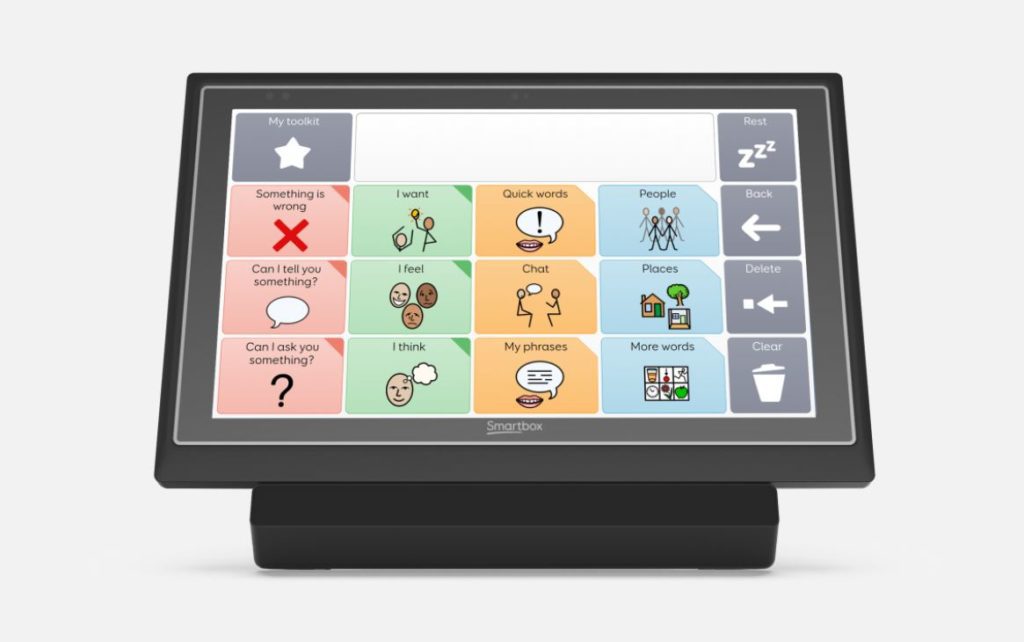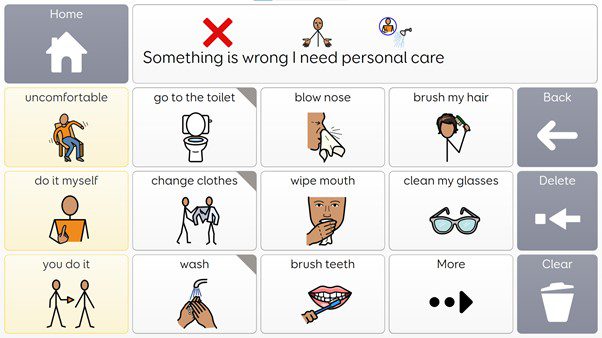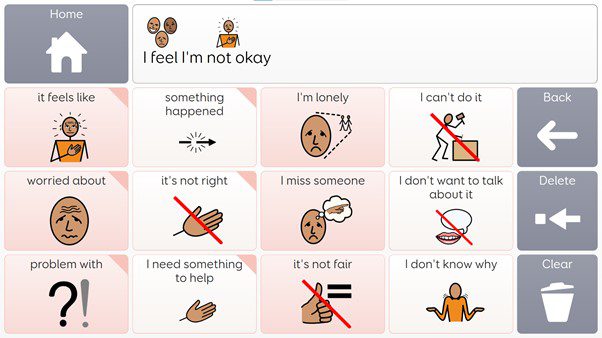Smartbox introduce Voco Chat
Supporting staff and students to achieve their full potential since 1968.
Welcome to our weekly CENMAC blog post
by Smartbox – Anita Kirby (Content Developer) and Daisy Clay (Head of Content)
In this week’s edition, CENMAC have invited the team at Smartbox to introduce Voco Chat, an AAC vocabulary designed to support communication, independence and emotional wellbeing.

Voco Chat is a new low cell-count vocabulary available in Grid AAC software. Using a pragmatic approach to language organisation, it has been designed to consider the many different reasons we communicate and encourages all of these with a supported approach to building messages. It is designed for individuals of any age who may need larger cells to help them make more accurate selections, or those who may benefit from fewer options on each grid due to difficulties with learning and memory.
Voco Chat is built on a foundation of six Message Pathways, which include many of the most important and common reasons we communicate. From saying when something is wrong to sharing your news and giving opinions, the Message Pathways help build a message by presenting relevant vocabulary as and when it is needed. Automatic navigation guides users through the vocabulary, meaning that they don’t have to worry about extra selections to jump between grids. This makes message building easier, faster, and more efficient – beneficial to AAC users with a learning disability, or complex, effortful access.
Voco Chat is designed to support individuals to develop their communication and interaction skills further, with language to help someone initiate and maintain a conversation, as well as fix it when something goes wrong. There is vocabulary to support independence across different contexts as well as language to give the user ownership over their own care, communication and medical needs. In addition, there are a number of tools built into the vocabulary designed to support users to express and manage their emotions, report when something is not okay, and talk about their mental wellbeing. This blog will explore each of these in more detail.
Communication and interaction
Alongside the six Message Pathways in Voco Chat which allow a user to convey key messages such as making requests, asking questions and telling someone how they feel, there are also sections designed to support individuals to develop a wider range of communication and interaction skills.
Having conversations and building relationships
The Chat grid, which can be accessed from the home grid, provides conversational support designed to encourage users to engage in day-to-day interaction about any topic, and goes beyond the typical introduction style questions often found in AAC vocabularies. This grid is structured around a typical conversation, with each column representing a different stage. The first column supports users to initiate a chat with common greetings such as “hi” and “how are you?” There is the option to add further opening phrases via the More greetings jump. The second column of the grid supports users to maintain a conversation, with comments such as “tell me more,” “really?” and “no way!” whilst the third column provides phrases that are useful to address misunderstandings and other conversation breakdowns. The Chat help jump at the bottom of this column provides access to a wider range of phrases to support a user when the conversation has gone wrong, such as “that’s not what I meant” or “I can’t find the word I need.” The final column in this grid allows users to end a conversation naturally – not just saying goodbye – for example by saying “I’ve got to go now” or “it was great to see you.” Day-to-day conversations with familiar people are a critical part of interaction and enable us to fulfil one of the key reasons for communication, beyond simply making requests and having needs met – to develop social relationships with others (Light, 1997). Voco Chat was designed with this in mind.
Problem solving and communication breakdown
Another important skill which any symbol AAC user must learn is what to do when they can’t find the word they need, or don’t have that word programmed into their vocabulary. This strategic competency, as first described in 1989 by Janice Light, continues to be a highly relevant and necessary part of AAC intervention today. In addition to the Chat help section already mentioned (which can be accessed through various routes within the vocabulary), there are additional supports within the My toolkit section of Voco Chat. One such tool is a cell which says, “Can I give you a clue?” This cell takes the user to a grid containing links to action, describing and time words, as well as offering useful options, such as suggesting that their communication partner asks them yes or no questions. There are also jumps to grids for describing people, as well as links to general vocabulary for people, places and general topics such as clothes or vehicles. By saying “Can I give you a clue?” the AAC user has communicated that what comes next is not necessarily exactly the word they are looking for but might be related to it. The grid for describing people can also be accessed via the People jump from the home grid, so a user can easily talk about someone whose name they do not know, for example, the blond man or tall woman with glasses – particularly useful for anyone with complex needs, who might see many care or health professionals and not always catch their name.

Talking about how you communicate
Also within the My toolkit section is an area called My AAC. This has been designed around the idea of a Communication Passport (Millar & Aitkin, 2003) and includes grids to add information about how the user communicates, what someone can do to support their communication, what communication skills they might currently be working on and what to do if they are upset. Unlike a paper-based communication passport which may often be shared by professionals working with the AAC user, this section of Voco Chat has been deliberately made accessible to the user themselves so they can take ownership of their information and share it with the people they meet.
Independence
As a pragmatically organised vocabulary, Voco Chat includes several ways to ensure that an individual can express what they want and need. Whether this is through the “Something is wrong” or “I want” message pathways, a user can request things they need or want across different contexts, from something to eat or drink, to an activity they want to do, or simply requesting a break when they need one.
Control over personal care needs
In addition to this however, Voco Chat has features designed to support an individual’s journey towards further independence. For example, within the “I want” pathway there is an option to request personal care. This gives users more control to not only request but also direct their personal care, asking someone to wipe their face, change their clothes, or help them use the toilet, amongst other things. Providing vocabulary for these daily events is intended to help AAC users take a more active role in their personal care, as well as having the option to talk about the details of their care needs.

Health and dietary needs
Also within Voco Chat, users will find grids to enable them to talk about their health or dietary needs. Some of these grids have been left blank so that the individual’s own information can be added, whilst others contain some common vocabulary such as “allergy” and “inhaler.” A dietary requirements grid includes common vocabulary such as vegetarian, but also dysphagia specific terms such as mashed, pureed, and thickened. Many people who have dysphagia – that is, eating and drinking difficulties – will have associated communication difficulties and may require AAC. It is therefore vital to provide AAC users who have dysphagia with the means to talk about what help they need to eat and drink safely and take part in managing their difficulties (Hemsley & Balandin, 2009).
Just as the My AAC and Personal care sections do, these grids are designed to give an AAC user more independence and ownership over these aspects of their lives by allowing them to communicate their needs to others.
Emotional wellbeing
Individuals with complex communication needs may need additional support to identify, talk about and manage how they are feeling. This can start from simply labelling their emotions using the “I feel” pathway, but there are also other emotional wellbeing features included with Voco Chat.
Looking after your mental health
Within the “I feel” pathway there is a cell labelled “I’m not okay.” This takes the user to an area of Voco Chat that was specifically designed to support someone to talk about their mental health and wellbeing. Moreover, its design and vocabulary choices were based on the work of the Foundation for People with Learning Disabilities (2004) and their project to create an easy read guide on looking after your mental health. The “I’m not okay” section in Voco Chat provides accessible language about mental ill health, including what it might feel like in terms of physical symptoms, what someone may be worried about, and suggestions of things that might help them feel better.

Safeguarding and reporting a problem
Voco Chat includes the language needed to say when something bad has happened or when something is not right. This once again recognises the fact that AAC users may depend on other people to meet their care needs and may unfortunately need a way to say if their care needs have not been met. The “I’m not okay” grids can also be reached via My toolkit and are an important part of the vocabulary when thinking about emotional wellbeing.
Self-talk and emotional regulation
Two other areas of the toolkit may also support an individual to manage their emotions. These are the Self-Talk and Calming Down grids. Self-talk is another way of referring to the internal dialogue which everyone experiences to some degree and has been recognised as one of the key functions of communication (Beukelman & Light, 2020). Positive self-talk is often recognised as a useful tool to enhance wellbeing and the need to provide access to self-talk phrases has previously been highlighted within the field of AAC (Ahern, 2017).
Within My toolkit there is a jump labelled “I’m talking to myself.” This cues anyone around the AAC user that what comes next is not intended as part of a conversation, but is a message intended for the AAC user themselves. The grid contains some examples of positive self-talk which can be adapted and changed to suit each individual, as well as space to add extra messages. It may help a user reassure or encourage themselves and may help promote positive thinking.
Finally, the Calming Down area of the toolkit is designed to help users who may have difficulties regulating their emotions. It provides strategies which may support someone to calm down when they are feeling overwhelmed or overstimulated. These can be used as visual prompts for the user to remind them of their options or could be spoken aloud to tell a communication partner what the user needs at that time. As with the self-talk grid, the suggestions in this grid are designed to be adapted and personalised to suit each individual.
In summary, Voco Chat is designed to go beyond simply supporting someone to communicate their wants and needs. With the AAC user in mind, Voco Chat is intended to enable people to engage in conversations, build social relationships, increase independence, and encourage positive mental health and wellbeing.
Voco Chat is now included with Grid for Windows and iPad and you can try it for free with our Grid software trial. Find out more about the grid set itself and download your trial today at thinksmartbox.com/voco-chat.
References:
Ahern, K. (2017). ‘Just Talking to Myself, Don’t Mind Me: Teaching Internal Dialogue to AAC Users with Complex Needs’, Teaching Learners with Multiple Special Needs Blog, 27 April. Available at:
https://teachinglearnerswithmultipleneeds.blogspot.com/2017/04/ just-talking-to-myself-dont-mind-me.html
Beukelman, D. R., & Light, J. C. (2020). Augmentative & Alternative Communication: Supporting Children and Adults with Complex Communication Needs (5th ed.). Baltimore: Brookes.
Foundation for People with Learning Disabilities (2014). Feeling Down: Looking After My Mental Health: an easy read guide for people with learning disabilities. Available at:
https://www.mentalhealth.org.uk/sites/default/files/feeling-down-guide.pdf
Hemsley, B. & Balandin, S. (2009). Disability, dysphagia, and complex communication needs: Making room for communication in ethical decisions about dysphagia. Advances in Speech Language Pathology, 5:2, 125-129.
Light, J. (1989). Towards a Definition of Communicative Competence for Individuals using Augmentative and Alternative Communication Systems, Augmentative and Alternative Communication, 5:2, 137-144.
Light, J. (1997). “Communication is the essence of human life”: reflections on communicative competence, Augmentative and Alternative Communication, 13:2, 61-70.
Millar, S. & Aitkin, S. (2003). Personal Communication Passports: Guidelines for Good Practice. CALL Centre, University of Edinburgh Press.
Many thanks to Anita and Daisy at Smartbox. The CENMAC team hope you have enjoyed this feature and would encourage you to share your experiences of Assistive Technology with our community.
Don’t forget you can share your CENMAC experiences for our CENMAC family to enjoy. Plus, sign up for our newsletter to read more about Education, Technology and Communication Works 2022 (North & South).



